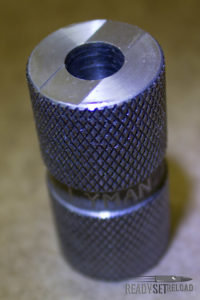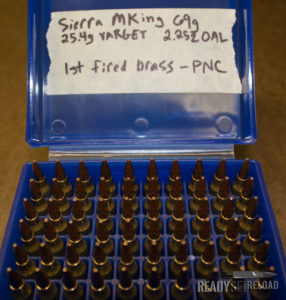Making Live Rounds
This is the final section of this series. If you’ve read each of my posts you now have all the knowledge for making live rounds. The main purpose of this section is to show you how quickly creating live rounds can be accomplished by using my methods and tools.
At this point you should have all of your trimmed brass primed and in trays. Your press should be adjusted so the cartridge over all length (COAL) is adjusted to the proper specification after seating a bullet. Finally, if you are reloading for a magazine fed rifle like an AR-15 double check to make sure your COAL is short enough to fit into the magazine. Everything is now in place to start making live rounds. Before we start lets discuss another tool you will need which is called a case length headspace gauge.

Lyman Case Length Headspace Gauge
After you seat each bullet it’s a good idea to measure the COAL double checking that it’s correct so pressures inside your chamber remain consistent between each shot. This effects the accuracy of your handloads but more importantly your personal safety depends on this. You will also need to visually inspect each round to make sure the crimp is correct and that you’ve not missed a cracked piece of brass or something else that could cause a catastrophic failure. A quick way to make sure your brass is to correct spec is to use a case length headspace gauge.
After each completed round is taken off the press visually inspect it one last time for cracks in the brass then place it in the gauge. The gauge is machined to Sporting Arms and Ammunition Manufacturers’ Institute (SAAMI) specs. If the round is not in spec it will not fit in this gauge. The exception being the COAL; every ten rounds or so use your calipers to make sure your die didn’t come out of adjustment. If this happens you should use your bullet puller to disassemble the round, deprime then resize and/or re-trim the brass. Don’t try to fire the round as you might have problems with it chambering or worse yet you blow off your face.
Here is my very straightforward process for making live rounds:
- Using your powder measure, charge a piece of primed, trimmed brass.
- Insert a piece of charged brass in your press.
- Insert a bullet into the mouth of the brass while you raise the ram on your press as far as it goes.
- Lower the ram on your press and remove the live round.
- Visually inspect the live round for cracks in the brass, proper primer seating, etc. (this is your last chance!)
- Insert the live round into the case length headspace gauge making sure it properly fits.
- If the round is good put it in your ammo can. If the round is bad put it in a pile for disassembly.
That’s it, your ready to shoot. Once I get to the range I’ll post a picture of my target so you can see the kind of accuracy I get. Happy reloading!

.556 Reloaded Ammunition
Equipment used in this post:

